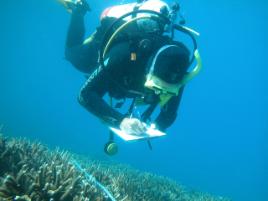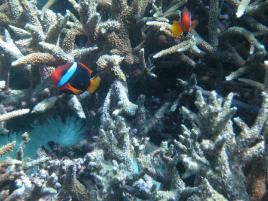CQU researchers to put coastal reefs under the spotlight
Published on 20 July, 2007
Our coastal fringing reefs may be close but they are often forgotten. That's all about to change thanks to funding provided by the Burnett Mary Regional Group which recently allocated $220,000 to allow Central Queensland University's Centre for Environmental Management to map the reefs and co-existing habitats.
The fringing reefs about to be mapped and studied are within close proximity to the coast of Tannum Sands down to Burrum Heads (North of Marybourgh).
According to the CEM's Dr Ashley Bunce, Program Leader of the project, the fringing coastal reefs have been overlooked for too long. 
A CEM researcher recording types of coral for the reef mapping project.
Fringing reefs are a crucial habitat for a wide variety of fish species.
"Many people know of them, particularly our weekend fisherman, but there are very few documented reports.
"Most of the attention and studies are on the Great Barrier Reef system but the fringing reefs are equally as vital to the ecosystem. They are a crucial habitat for a wide variety of fish species and other sea creatures, providing nursery habitats for many resident estuarine fish and a stepping stone for many juvenile reef fish," said Dr Bunce.
Research officer for the project, Dr Ralph Alquezar said a lot of work has been done for the pilot project, which led to the subsequent funding from BMRG.
"Over the next 12 months we will be going out to the reefs, mapping them and creating a data base on what types of corals exist, how much of it is hard or soft, dead or alive and whether there is any bleaching occurring," said Dr Alquezar.
The information will then be used to provide a report card to those who have a role in managing the health of local reefs such as local councils and Natural Resource Management groups.
"It's important that our reef managers have an understanding of what is out there so that they can make informed choices to ensure the protection of these valuable reef systems.
"The other important point for all Gladstone residents to remember is that the reefs are there for their enjoyment. They are easily accessible and you can see some amazing fish species and corals without having to visit a resort," said Dr Alquezar.
Some of the more local fringing reefs include Jenny Lind Banks, Sable Chief Rocks, and reefs off Facing Island and Hummock Hill Island.

